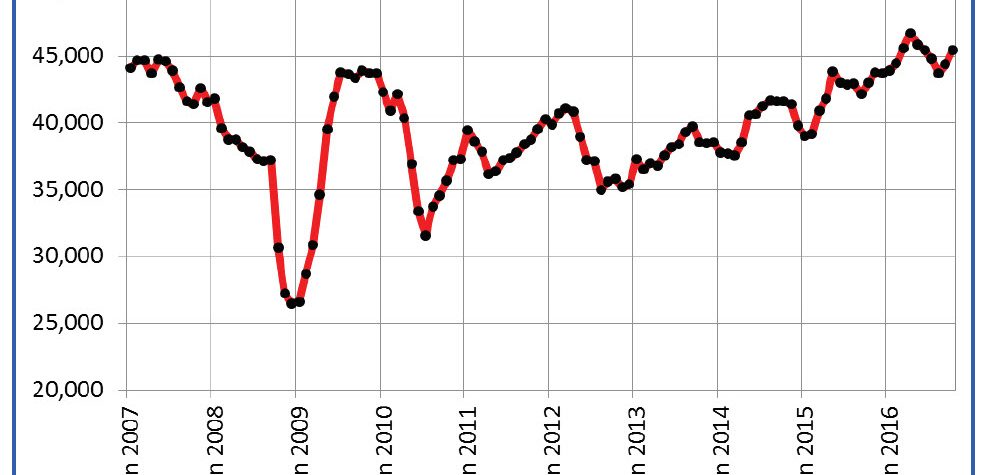Ottawa, ON, November 15, 2016 – According to statistics released today by The Canadian Real Estate Association (CREA), national home sales were up on a month-over-month basis in October 2016.
Highlights:
- National home sales rose 2.4% from September to October.
- Actual (not seasonally adjusted) activity was up 2.0% year-over-year (y-o-y) in October 2016.
- The number of newly listed homes edged up 1.7% from September to October.
- The MLS® Home Price Index (HPI) in October was up 14.6% y-o-y.
- The national average sale price climbed 5.9% y-o-y.
 The number of homes trading hands via Canadian MLS® Systems rose 2.4 percent month-over-month in October 2016.
The number of homes trading hands via Canadian MLS® Systems rose 2.4 percent month-over-month in October 2016.
Activity was up on a month-over-month basis about 60 percent of all local markets, led by the Fraser Valley, Calgary, Edmonton, Hamilton-Burlington and Montreal.
“The expanded stress-test for home buyers who need mortgage default insurance took effect in the middle of October,” said CREA President Cliff Iverson. “More time will need to pass before its effect on housing markets can be gauged. The extent to which they will push first-time home buyers to the sidelines may vary among housing markets. All real estate is local, and REALTORS® remain your best source for information about sales and listings where you live or might like to in the future.”
“First-time home buyers looking to get into the market before having to face tougher mortgage eligibility criteria had only two weeks to do so following the Finance Minister’s announcement of tighter mortgage regulations in early October,” said Gregory Klump, CREA’s Chief Economist. “Early evidence suggests that the influence of tighter mortgage regulations on sales activity has been mixed. The federal government will no doubt want to monitor the effect of new mortgage regulations on the many varied housing markets across Canada and on the economy, particularly given the recent rise in uncertainty about economic growth prospects following the U.S. presidential election.”
Actual (not seasonally adjusted) sales activity rose 2 percent y-o-y in October 2016 to set a record for the month, edging out the previous record set back in October 2009 by just 0.8 percent.
Transactions were up from year-ago levels in about 60 percent of all Canadian markets, with activity gains in the Greater Toronto Area (GTA) and environs offset by y-o-y declines in B.C.’s Lower Mainland.
The number of newly listed homes climbed 1.7 percent in October 2016 compared to September. Led by a marked increase in the GTA, new listings were up from the previous month in about 60 percent of all local markets.
With sales having risen by slightly more than new listings in October, the national sales-to-new listings ratio edged higher to 62.9 percent compared to 62.4 percent in September.
A sales-to-new listings ratio between 40 and 60 percent is generally consistent with balanced housing market conditions, with readings below and above this range indicating buyers’ and sellers’ markets respectively.
The ratio was above 60 percent in half of all local housing markets in October, the vast majority of which continue to be located in British Columbia, in and around the Greater Toronto Area and across Southwestern Ontario. The ratio has moved out of sellers’ market territory and into the mid-50 percent range in Greater Vancouver.
The number of months of inventory is another important measure of the balance between housing supply and demand. It represents the number of months it would take to completely liquidate current inventories at the current rate of sales activity.
There were 4.5 months of inventory on a national basis at the end of October 2016 – the lowest level in almost 7 years.
The tight balance between housing supply and demand in Ontario’s Greater Golden Horseshoe region is without precedent (including the GTA, Hamilton-Burlington, Oakville-Milton, Guelph, Kitchener-Waterloo, Cambridge, Brantford, the Niagara Region, Barrie and nearby cottage country). In October, the number of months of inventory ranged between one and two months in many of these housing markets, and has slipped to below one month in Mississauga, the Durham Region, Orangeville, Cambridge and Guelph.
 The Aggregate Composite MLS® HPI rose by 14.6 percent y-o-y in October 2016, up from 14.4 percent in September.
The Aggregate Composite MLS® HPI rose by 14.6 percent y-o-y in October 2016, up from 14.4 percent in September.
On a y-o-y basis, price growth accelerated for two-storey single family homes and apartment units while slowing for townhouse/row units.
Benchmark prices for two-storey single family homes and townhouse/row units posted the biggest y-o-y gains in October 2016 (16.7 percent and 16.0 percent respectively). Price increases were not far behind for one-storey single family homes (14.0 percent) and apartment units (11.4 percent).
While prices in 9 of the 11 markets tracked by the MLS® HPI posted y-o-y gains in October, increases continue to vary widely among housing markets.
Greater Vancouver (+24. 8 percent) and the Fraser Valley (+32.5 percent) posted the largest y-o-y gains, although single family home prices in both of these markets are now off peak.
Double-digit y-o-y percentage price gains were also registered in Greater Toronto (+19.7 percent), Victoria (+20.1 percent) and Vancouver Island (+15.8 percent).
By contrast, prices were down 4.1 percent y-o-y in Calgary. Although home prices there have held mostly steady since May, they have been below year-ago levels since August 2015 and are down 5.1 percent from the peak reached in January 2015.
Home prices also edged lower by 1.3 percent y-o-y in Saskatoon. Home prices in Saskatoon have also held below year-ago levels since August 2015.
Meanwhile, home prices posted y-o-y gains in Regina (+4.5 percent), Ottawa (+3.0 percent), Greater Moncton (+2.8 percent) and Greater Montreal (+2.6 percent).
The MLS® Home Price Index (MLS® HPI) provides the best way of gauging price trends because average price trends are prone to being strongly distorted by changes in the mix of sales activity from one month to the next.
The actual (not seasonally adjusted) national average price for homes sold in October 2016 was up 5.9 percent y-o-y to $481,994.
The national average price continues to be pulled upward by sales activity in Greater Vancouver and Greater Toronto, which remain two of Canada’s tightest, most active and expensive housing markets.
That said, Greater Vancouver’s share of national sales activity has diminished considerably of late, resulting in it having less upward influence on the national average price. Even so, the average price is reduced by more than $120,000 to $361,012 if Greater Vancouver and Greater Toronto sales are excluded from calculations.
– 30 –
PLEASE NOTE: The information contained in this news release combines both major market and national sales information from MLS® Systems from the previous month.
CREA cautions that average price information can be useful in establishing trends over time, but does not indicate actual prices in centres comprised of widely divergent neighbourhoods or account for price differential between geographic areas. Statistical information contained in this report includes all housing types.
MLS® Systems are co-operative marketing systems used only by Canada’s real estate Boards to ensure maximum exposure of properties listed for sale.
The Canadian Real Estate Association (CREA) is one of Canada’s largest single-industry trade associations, representing more than 115,000 REALTORS® working through some 90 real estate Boards and Associations.
Further information can be found at http://crea.ca/statistics.
For more information, please contact:
Pierre Leduc, Media Relations
The Canadian Real Estate Association
Tel.: 613-237-7111 or 613-884-1460
E-mail: pleduc@crea.ca


